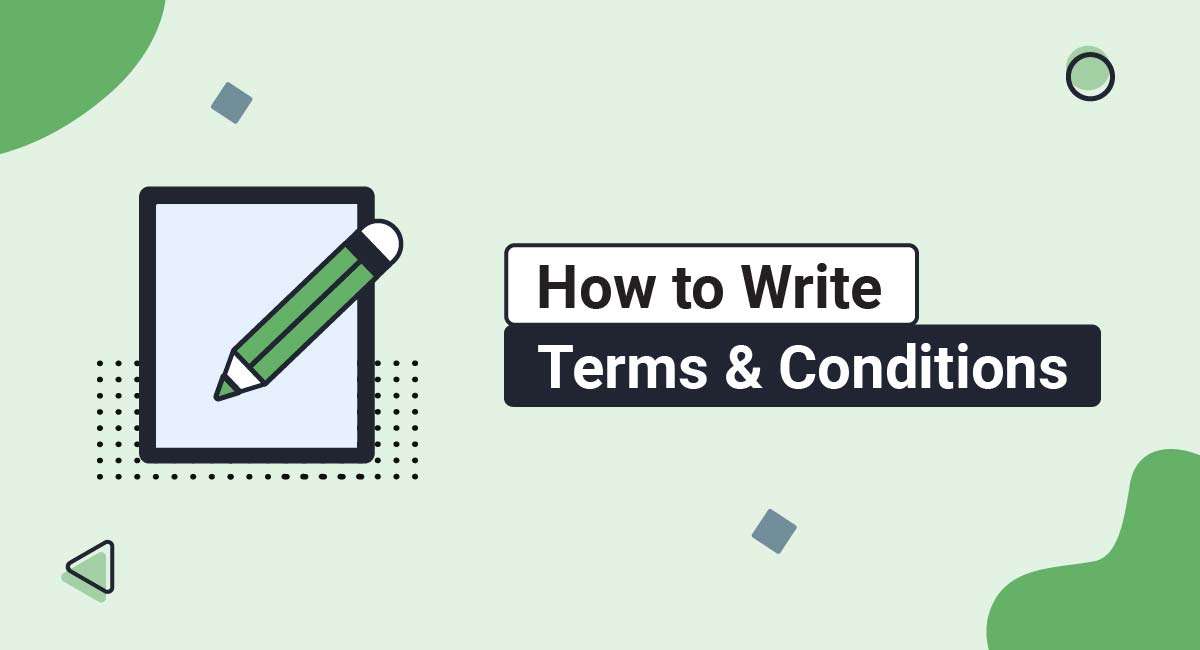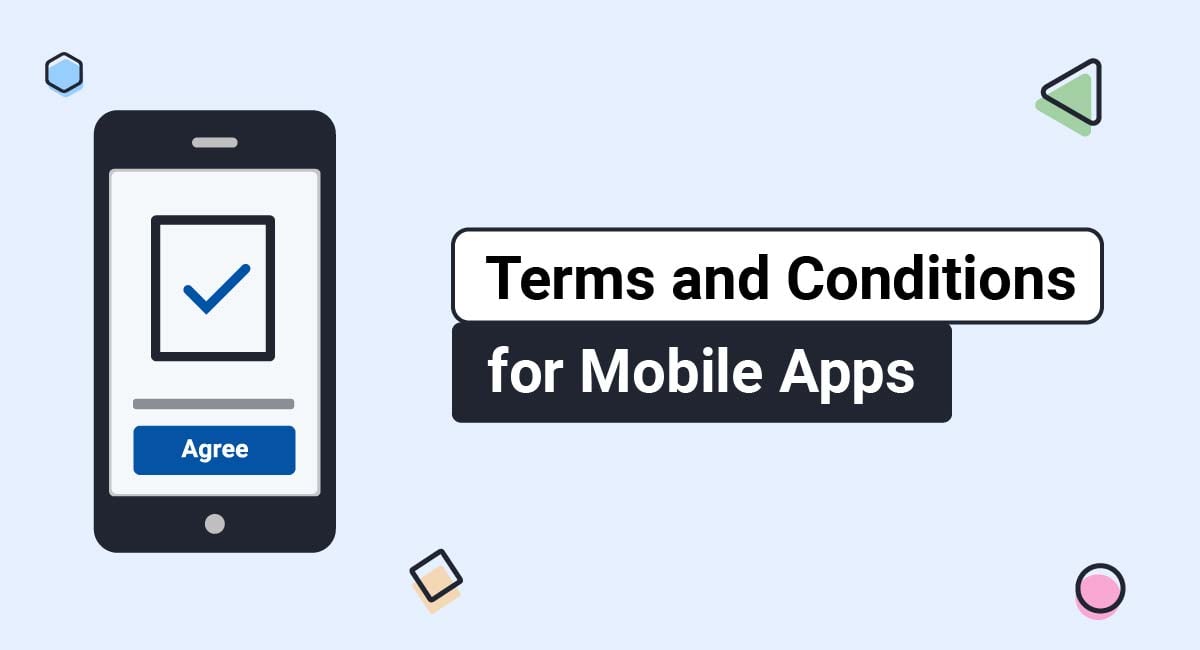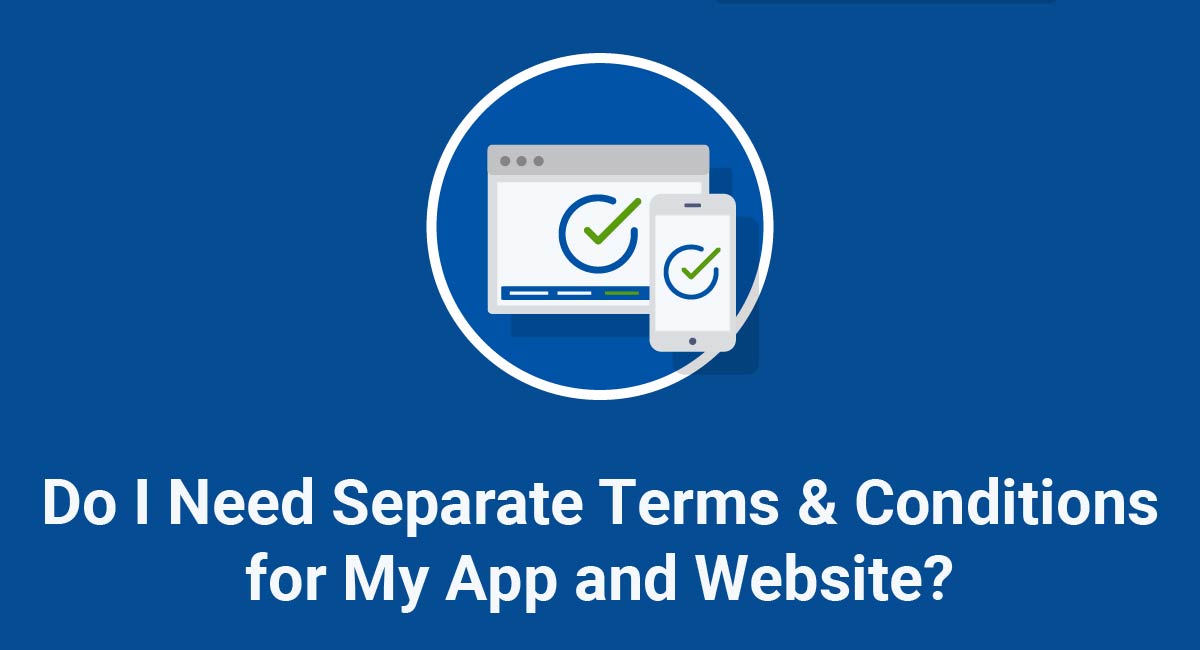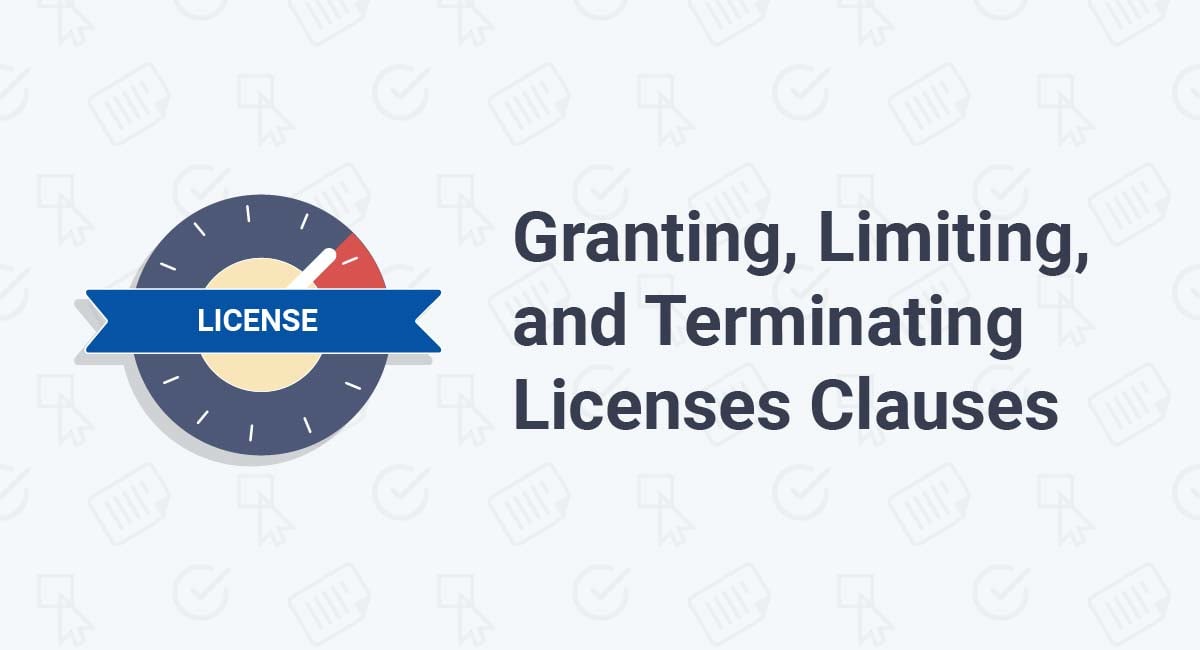Your Terms & Conditions agreement, also known as Terms of Use or Terms of Service, acts as a contract between you and your users so you can control liability, manage use of your website or service, protect your intellectual property, and enforce your rules of conduct.
While having a Terms & Conditions agreement it's not legally required in any jurisdiction, it can make managing your website or app much easier.
This article and outline will help you draft and write a basic yet complete Terms & Conditions agreement for your app or website.
Our Terms and Conditions Generator makes it easy to create a Terms and Conditions agreement for your business. Just follow these steps:
-
At Step 1, select the Website option or the App option or both.
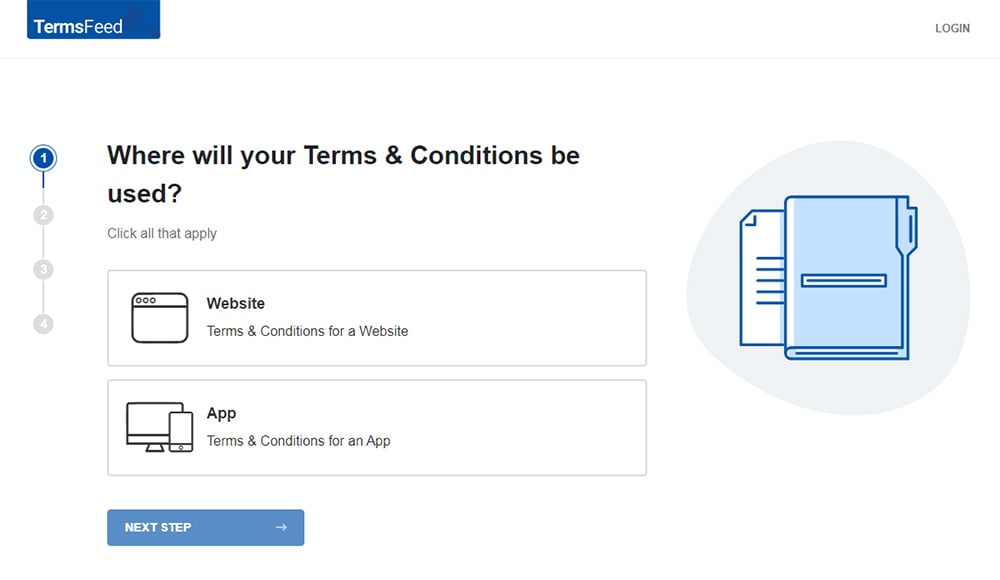
-
Answer some questions about your website or app.
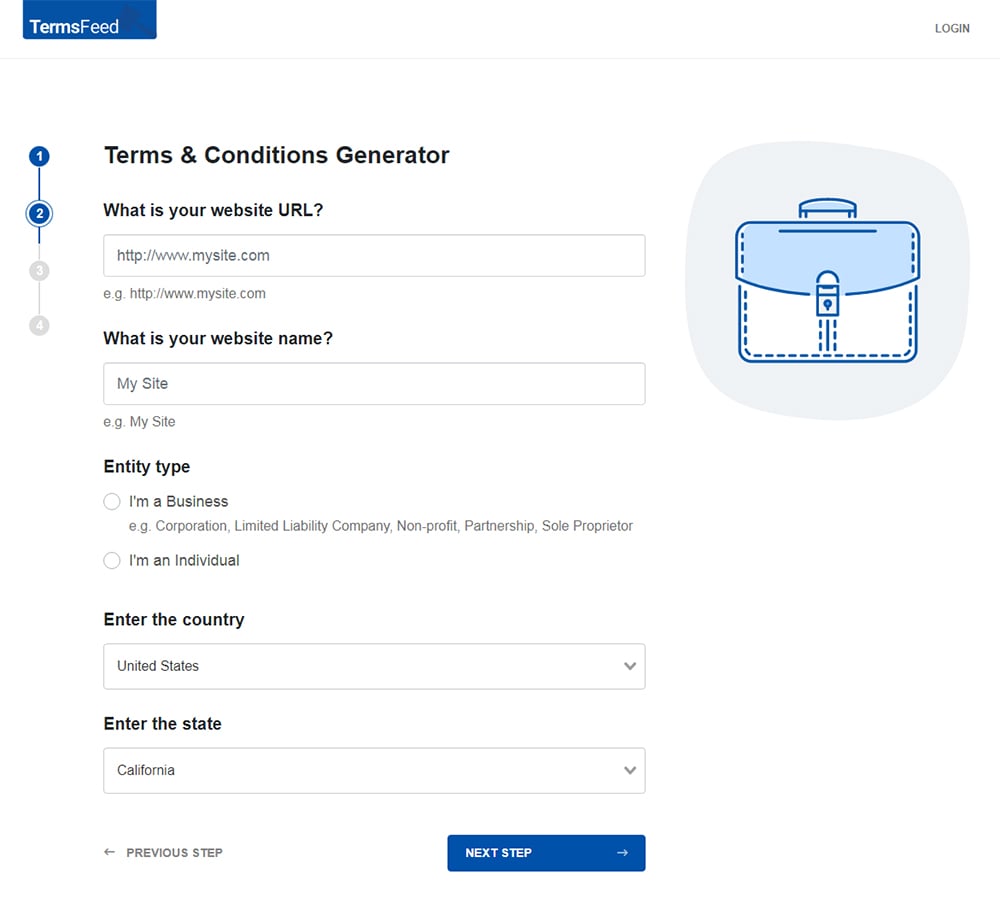
-
Answer some questions about your business.
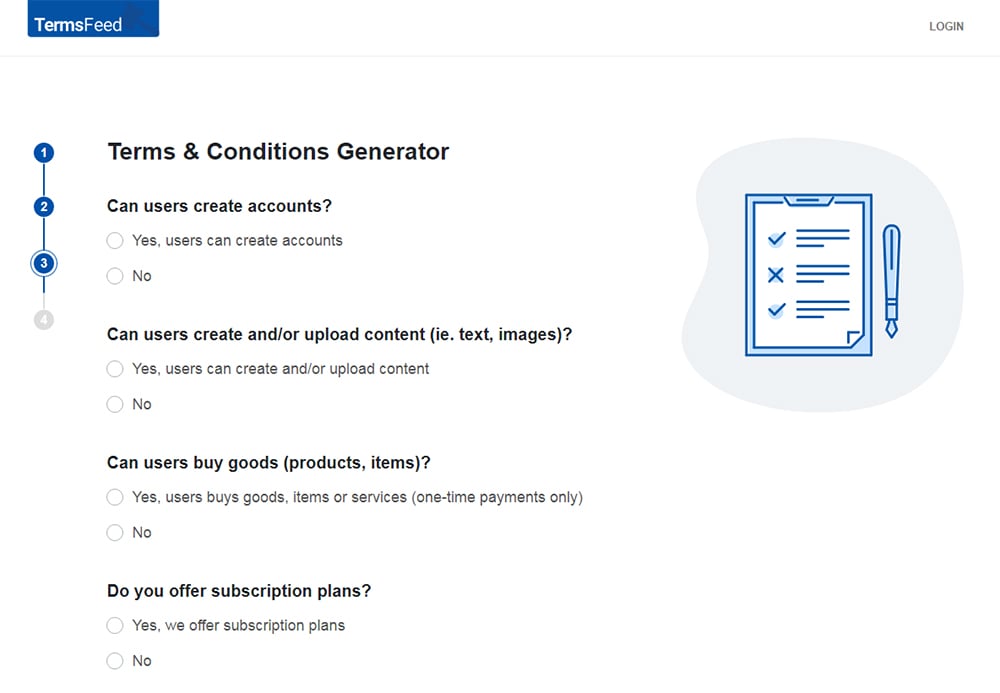
-
Enter the email address where you'd like the T&C delivered and click "Generate."
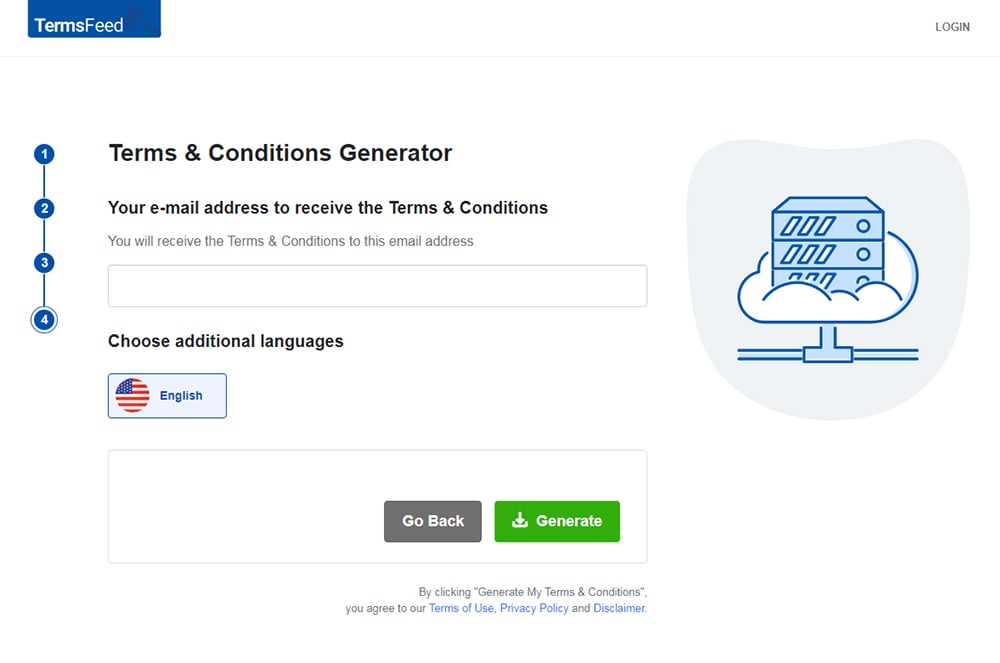
You'll be able to instantly access and download the Terms & Conditions agreement.
- 1. Before You Write Your Terms & Conditions
- 1.1. Understand Your Reasons
- 1.2. Set Your Ground Rules
- 1.3. Where Will You Display Your Terms and Conditions Agreement
- 1.4. Terms & Conditions in Plain Language
- 2. Writing Your Terms & Conditions Agreement
- 2.1. Introduction and Acceptance of the Agreement
- 2.2. Privacy Practices
- 2.3. Limitation of Liability and Other Disclaimers
- 2.4. Intellectual Property Rights
- 2.5. Advertising and Endorsements
- 2.6. Payment Terms
- 2.7. Termination
- 2.8. Notification of Changes to the Terms and Conditions Agreement
- 2.9. Contact Information
- 3. Can I Copy Parts of my Terms and Conditions Agreement?
- 4. Why Should my Terms and Conditions Agreement be Unique?
- 5. Do I Need a Lawyer to Write my Terms and Conditions Agreement?
Before You Write Your Terms & Conditions
Before you write your Terms & Conditions for your app or website, understand why you need it and what you hope to accomplish with it. Otherwise, you're unlikely to create a complete agreement.
Understand Your Reasons
A Terms & Conditions agreement prevents users from abusing your service (or other users of your service), limits liability, and establishes any ownership in your trademarks, content, copyrights, and other intellectual property.
If you do not address these reasons at a minimum, you will limit your legal enforcement powers and claims against users.
As you write your Terms & Conditions agreement, keep these reasons in mind. It will help you avoid adding unnecessary material and help keep you focused.
The rest of this article addresses specific clauses that help you protect your interests.
Set Your Ground Rules
Make a list of any limits and rules regarding your website or app. You will work these into your Terms & Conditions agreement when you draft it.
For example, if you run a photo sharing site, you may prohibit sexually explicit material from being uploaded and shared on your site.
There may be age limits on who uses your app or website and those need to be enforceable, too. Some websites and apps require payment of subscription fees before access to content or features is allowed.
Take inventory of your rules before writing your Terms and Conditions agreement.
Where Will You Display Your Terms and Conditions Agreement
Once you finish your Terms & Conditions, you need to post it in a conspicuous location on your website or within your app.
On websites, the Terms & Conditions should be accessible through links. Many companies post links to the Terms & Conditions throughout their website pages, usually in the footer.
If there is a sign-up form, acceptance of the Terms & Conditions should be mandatory before setting up an account.
Aside from a footer and sign-up form, links to the Terms & Conditions may also be posted in:
- FAQ pages
- Throughout user forums or community sections
- An About or Legal Info menu within a mobile app
Your Terms & Conditions agreement does not help you if the user cannot find the agreement or is not required to accept the agreement and its terms. Consider this carefully before you release your app or website.
Check out our Terms and Conditions FAQ for more information about these important agreements.
Terms & Conditions in Plain Language
It's becoming more common to find the Terms & Conditions written in plain language or with summary notes provided along with it. This works in your favor. Vague documents can be thrown out in court and construed against you.
Pinterest offers a good example if you believe this can work for you. While the Terms & Conditions has the typical provisions, it also offers notes in the margin:
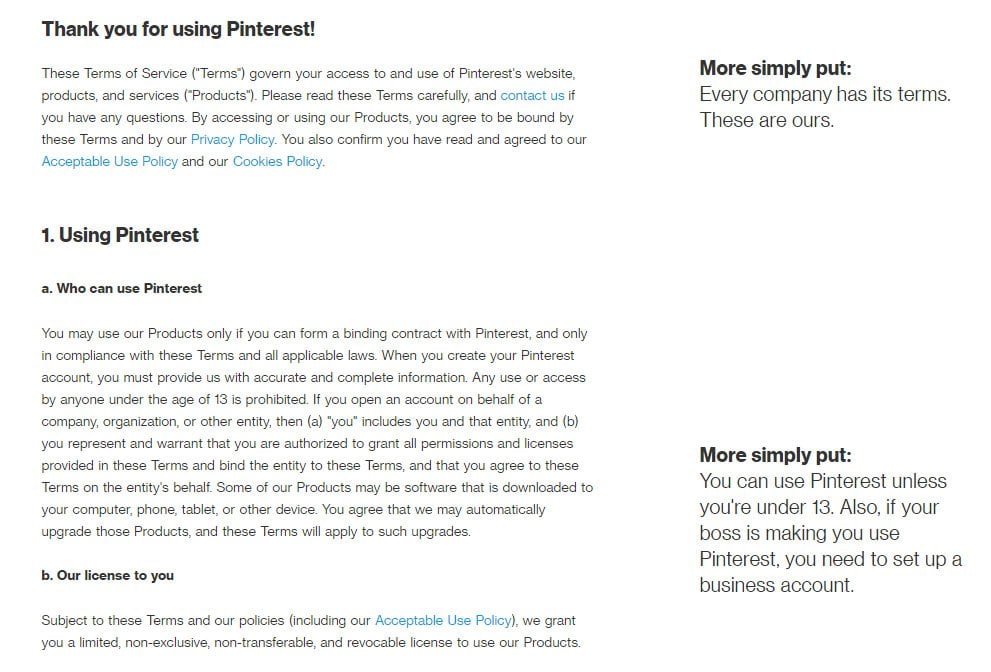
The Terms & Conditions is the best way to protect your company from liability, manage user behavior, and create reasonable expectations. Using these steps, you can write a basic Terms & Conditions that offers all of these benefits.
Writing Your Terms & Conditions Agreement

Once you understand your reasons and priorities for having a Terms & Conditions agreement, it's time to start writing.
Here are some of the most common and important clauses you'll see across the board in most Terms & Conditions agreements.
Introduction and Acceptance of the Agreement
All of the efforts you put into writing a Terms & Conditions is wasted unless the user agrees to be bound by it. Many apps and websites make users accept the agreement at signup or login.
Sometimes this can be done by using an "I agree" checkbox. Learn more about the differences between "browsewrap" and "clickwrap" methods of enforcing your agreements in our Browsewrap and Clickwrap guide here.
This example from TripAdvisor shows how you can let users know that by signing into an account, they're agreeing to your terms:
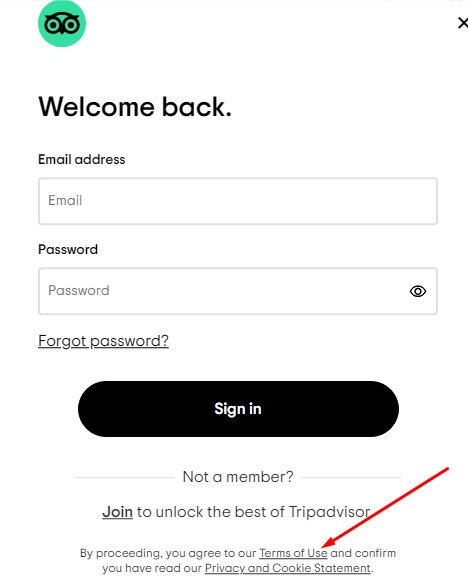
However, this is not enough on its own. You still need acceptance terms in your Terms & Conditions agreement.
Focus@Will explains that use of its service constitutes agreement to its terms. People who do not wish to follow the T&C should not use the service:

Pinterest takes a similar approach with a better plain-language explanation:

Basically, the idea you need to get across here is that use of your services means acceptance of the terms outlined in your agreement. This is the basis that makes your Terms & Conditions enforceable.
Privacy Practices
Unless you don't collect any personal information, you'll likely draft a separate Privacy Policy which you can then link to your Terms and Conditions agreement.
Privacy Policies are required throughout the world including the E.U., Canada, and Australia, just to name a few..
You'll also mention privacy in your Terms & Conditions agreement. This works as reassurance to users that their privacy rights are being respected.
All you need to do is note that you have a Privacy Policy, and provide a link to it.
Here's how RescueTime does this:

Car2go takes a similar approach in its Terms & Conditions agreement on memberships:

If you are writing your own Terms & Conditions, this simple approach is likely the best approach to drafting this section.
You're more likely to maintain consistency with your company's Privacy Policy which also helps with enforcing your agreements.
Limitation of Liability and Other Disclaimers
You want to include general limitation of liability clause in your Terms & Conditions agreement. Without it, your users could pursue damages for shutdowns, viruses, and failure of your app, website or software.
Even if you don't anticipate any issues, it's often what you never expected that gets your company in legal trouble.
Generally, you want it to be clear to your users that you will not be responsible for damages arising from the use of your service. You'll also want to inform users that their use of your app or website may come with risk, even if that possibility is small.
ZenDesk has a very standard limitation of liability clause, all in caps. General waivers like this often work in your favor as they apply to many products and situations:
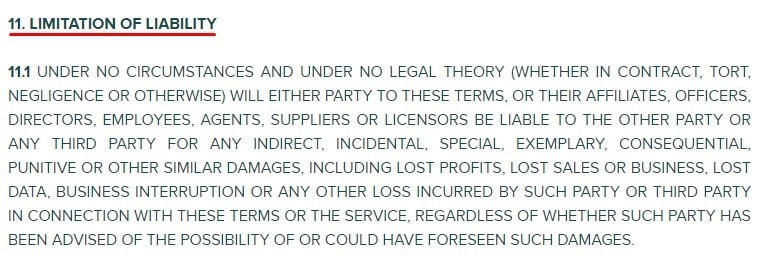
If your service (app or website) is specialized with a good chance that users may misinterpret your intentions, specific disclaimers are also helpful.
WebMD provides general medical information, but the information is not intended as medical advice. It includes this specific disclaimer in its T&C to prevent misunderstanding:
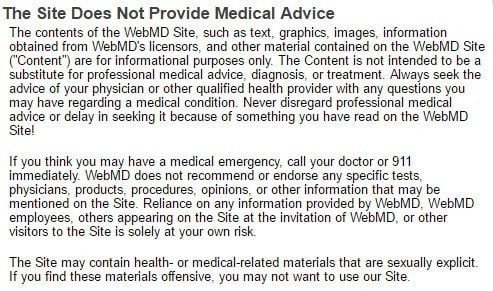
Read more about different types of disclaimers that may benefit your Terms and Conditions agreement in our Disclaimer Examples article.
Intellectual Property Rights
Include a clause that claims ownership over your intellectual property and forbids others from using it without your permission.
Any user with access to your site will also have access to your intellectual property. This includes trademarks, copyrighted material, proprietary algorithms, and other elements that make your website, app or service uniquely yours.
Using your intellectual property without permission or a license is infringement and is actionable under law. If a user does this, you want the ability to pursue an infringement claim but also terminate that user's access to your services.
The intellectual property section in a Terms & Conditions covers this situation.
If your app or website does not have a long international reach or your company owns little in the way of intellectual property, you can usually get away with a standard statement like this one:

Small companies that own several trademarks or copyrights or large companies with an international reach may need or prefer more detail in this section.
Insider Inc. is one example of this more in-depth approach. Between website trademarks and copyright ownership in articles, it offers this extensive intellectual property section in its Terms & Conditions agreement:
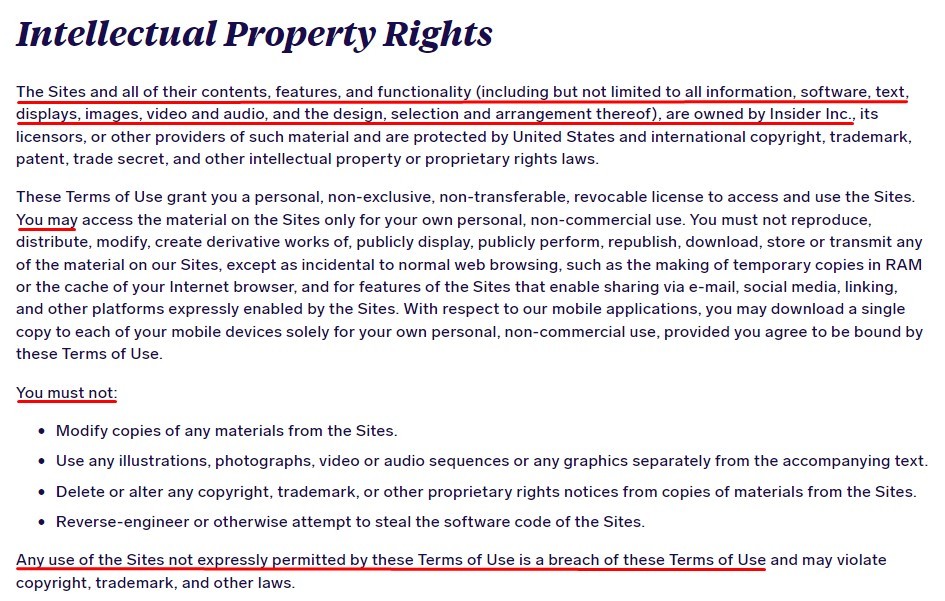
A general statement covers most of your intellectual property. However, if the risk of users misappropriating it is high, consider adding specific restrictions in this section.
Advertising and Endorsements
If you host advertisements from third parties, you should disclose those relationships even if you are not paid for them.
Besides revealing your connections to advertisers, you also want to waive any liability that may be connected to those ads. The use of user information in advertisements is reserved primarily for the Privacy Policy but you can still disclose your relationships and waive liability in the Terms & Conditions agreement.
Pandora keeps it brief with this statement:
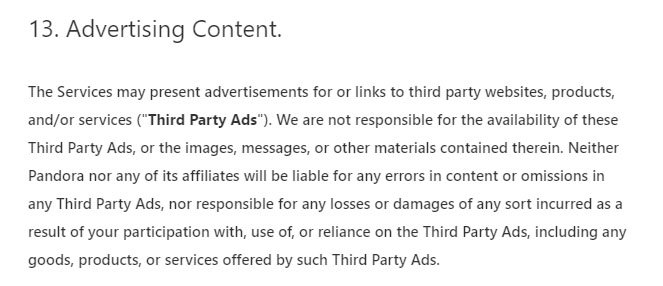
If your app or website does not display ads from third parties, you won't need to address this issue.
Payment Terms
Subscription services (like SaaS apps) must include payment terms in their Terms & Conditions.
This allows you to terminate service for non-payment and puts customers on notice that you require payment information. These provisions also indicate the frequency of payment and whether you offer monthly, quarterly or annual payment plans.
This section does not have to include payment amounts. You likely have a page with subscription plans and their cost, so this is not necessary information for the Terms & Conditions agreement.
Besides, this removes the obligation to change your Terms & Conditions agreement when you decide to adjust your prices or offer a new subscription plan.
The payment terms often explain how and when payment is due.
IndieCity discusses currency and its preference for credit or debit cards:
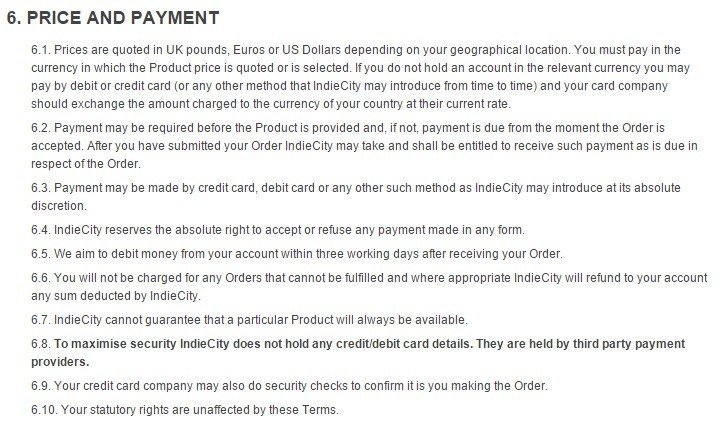
If you offer a free trial and payment incurs when that trial expires, you can address that issue.
Basecamp addresses this issue as well as upgrading and downgrading plans. There is also a link to the refund policy:
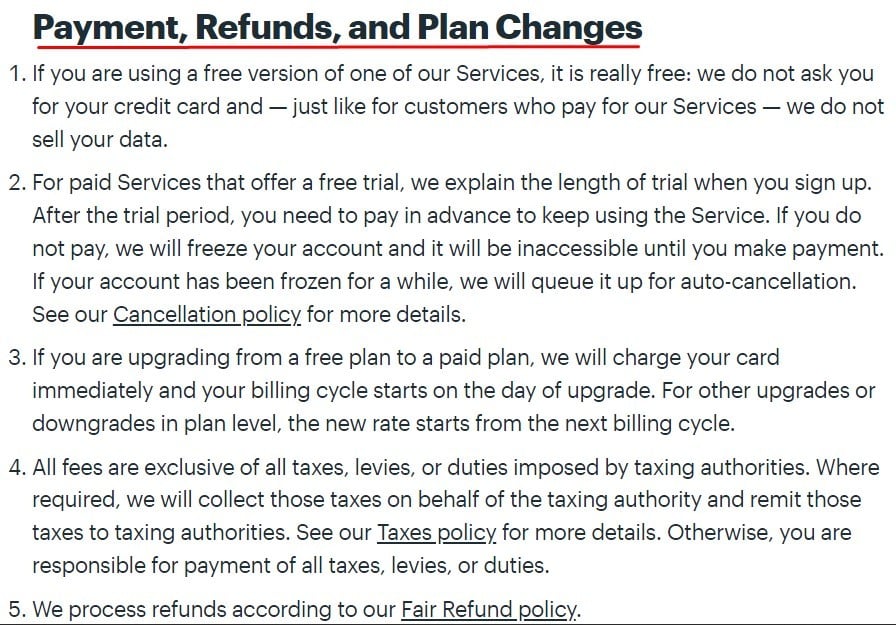
At the very least, you should include the frequency of payments and acceptable payment methods listed in this section. That will allow you to terminate users from your services for non-payment.
Termination
The termination clause retains your right to enforce the Terms & Conditions by terminating accounts that violate it. You can also simply maintain the right to terminate accounts for any reason you see fit.
Before it updated its Terms & Conditions agreement, Dropbox adopted a general approach to terminating accounts. It explains that users may stop using services at any time and a violation of the T&C results in account termination:
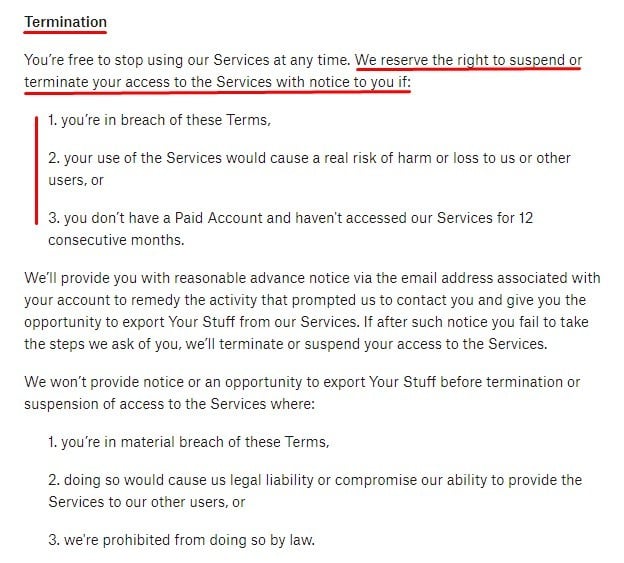
If there are user behaviors that are not tolerated, those should also be listed in your termination clause.
A general termination clause remains legally sufficient. This may be a good option for the short term if this is the first Terms & Conditions you write or if your app or website is new. Eventually, you may want to make it more specific, especially if you happen to come across an unusual situation that you want to explicitly acknowledge.
Notification of Changes to the Terms and Conditions Agreement
Your Terms & Conditions agreement will change as you learn more about your market and encounter new issues. Include a clause that states this, and how you will notify users of changes.
You still need to preserve your authority to make these changes and that happens through your Terms & Conditions. It's typically just a general statement indicating that you may change the Terms & Conditions and users will receive a notification.
You can put this under a "General" in your Terms & Conditions or give it its own heading. This is typically put at the end of the agreement.
Twitter places this explanation under a final "General" heading:

Dropbox likes to give specific reasons why its Terms & Conditions agreement may change. It also offers reassurance that users will be notified if the changes affect their rights and use of the service:

This provision should be in every Terms & Conditions agreement. Omitting it will likely not compromise your right to change your agreements but you will lack legal standing if a user takes action against you due to a change. Even a general statement like Twitter's clause is better than skipping this entirely.
Contact Information
End your Terms & Conditions with an invitation for users to contact you if they need clarification of the terms you have in your agreement.
This can be as simple as saying "Have questions, contact us" and offering an email address or telephone number.
Pandora keeps this short but allows users to communicate through a support team link:

Consider setting up a separate email address for these inquiries. That allows for better customer service and it is easier to designate employees to address the questions.
Can I Copy Parts of my Terms and Conditions Agreement?
Copying another company's Terms and Conditions could be unlawful, and isn't recommended regardless.
Copyright arises automatically when a person publishes written works online. This includes Terms and Conditions agreement content.
While most Terms and Conditions agreements look pretty similar, there are actually many subtle differences between each. Copying a company's Terms and Conditions word-for-word could violate its copyright.
It also means that your actual business practices and preferences may not be accurately reflected since your business is surely different than whatever one you'd be copying from.
For more information, see our article: Does Copying or Adapting Another's Terms & Conditions Violate Copyright Law?
Why Should my Terms and Conditions Agreement be Unique?

A Terms and Conditions agreement should reflect the reality of your business and its relationship with its customers. All companies are different, thus every Terms and Conditions agreement should be as well.
For example:
- You may charge users directly for your services, or you may rely on advertising revenue.
- If you do charge your users, you might do so on a weekly, monthly, or per-use basis.
- You may wish to create strict rules around what users can do on your platform, or you may wish to leave yourself a lot of freedom to restrict, suspend, or terminate users' accounts.
- Your "limitation of liability," "exclusion of warranties," and "indemnity" clauses must reflect local laws.
Your Terms and Conditions agreement is a crucial way for you to govern your company's relationship with its customers as you see fit. You should think carefully about what to include, and you should avoid taking too much inspiration from other companies' agreements.
Do I Need a Lawyer to Write my Terms and Conditions Agreement?

No, you don't necessarily need a lawyer to write your Terms and Conditions agreement.
Depending on your business's scale and context, it should be possible to use a customizable Terms and Conditions generator to help you create a valid Terms and Conditions agreement.
More complicated and larger-scale operations will require the support of a legal adviser or dedicated legal team. But for smaller and simpler businesses, you might be able to get by without legal assistance, so long as you plan and research carefully.
Bear in mind, however, that the courts will only enforce certain clauses in your Terms and Conditions agreement if they comply with the local laws governing consumer contracts.
You must also ensure that you obtain explicit acceptance of your Terms and Conditions if you want to rely on them in court. For example, this means that you should ask your customers to read your Terms and Conditions and tick a box if they agree with them.

Comprehensive compliance starts with a Privacy Policy.
Comply with the law with our agreements, policies, and consent banners. Everything is included.
